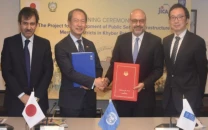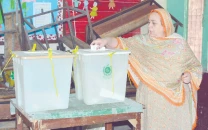Mapping the smog: Punjab’s real-time strategy for cleaner air
Punjab's data-driven smog control ensures accountability, strong enforcement, and better health outcomes

For decades, seasonal smog held Punjab hostage, causing health crises, grinding traffic to a halt, and devastating the environment. But in 2025, the provincial government declared war on the haze, trading old, temporary fixes for a bold new strategy driven by real-time data.
Instead of just reacting, Punjab is now measuring, mapping, monitoring, and enforcing pollution control like never before.
No major polluter is escaping scrutiny. Every brick kiln, industrial unit, vehicle, source of construction dust, and agricultural fire is being tracked, analysed, and instantly addressed.
This isn't just another cleanup effort; it's Punjab's most ambitious, data-driven air-quality management initiative in history, uniting cutting-edge technology, strong governance, and active citizen engagement to reclaim the air.
Eyes on the air: Real-time monitoring you can trust
Air-quality stations across the province now measure PM2.5 and PM10 continuously, giving residents real-time insight into the air they breathe. Combined with satellite imagery, AI analysis, and thermal drones, authorities can pinpoint pollution hotspots with unprecedented precision.

All readings are published on the AQI portal and the Green Punjab mobile app for at least 48 hours, allowing citizens to track changes, compare sites, and hold polluters accountable.
Even when a 12-hour display delay occurred on October 31 due to a technical glitch, the stations remained fully operational, no data was lost, and all readings were securely incorporated into the database, ensuring that the public always has access to reliable, verified information.
Mapping pollution: Turning data into action
The advanced mapping capabilities are not merely symbolic representations; they constitute a critical operational tool that enables highly targeted enforcement actions. Authorities now possess the capacity to precisely determine the origin of pollution, thereby facilitating swift and effective interventions.
• Brick kilns switching to zig-zag firing technologies
• 8,500 industrial units monitored centrally through AI
• Construction sites equipped with dust coverings and 371 mist sprinklers
• Vehicles tested under Pakistan’s first Emission Testing System, with 300,000 certificates issued
• Agricultural residue burning replaced by 5,000 super seeders, Kubota machines, and balers
Thermal drones and AI dashboards ensure inspections, fines, and sealing of non-compliant units are immediate and measurable.
Coordinated action across sectors: Everyone plays a role
The government's commitment to cleaner air is now an around-the-clock mission. Teams are working in three non-stop shifts, tackling pollution head-on by managing traffic flow, sprinkling water to settle dust, and rigorously inspecting industrial sites.
Concurrently, citizens are empowered to assume an active participatory role through accessible digital and communication channels, specifically the Green Punjab App, the dedicated eco-chatbot, and the Helpline 1373. These platforms facilitate the instantaneous reporting of violations and real-time access to live air-quality data.

This coordinated, multi-sector approach is integral to ensuring that all interventions are characterised by timeliness and precision, consequently yielding direct and measurable benefits for both public health and the environmental quality.
Proteting health: Every breath matters
Air pollution in Pakistan represents more than a mere environmental inconvenience; it constitutes a severe limitation on human longevity and public health.
Scientific studies indicate a direct correlation between fine particulate matter (PM 2.5) concentration and a significant reduction in average life expectancy across the country, estimated to be 3.3 years.
In regions experiencing particularly high levels of pollution, such as Lahore, the detrimental effect is even more pronounced, potentially resulting in a loss of up to seven years of life expectancy for the average resident.
Certain demographic groups, specifically children, the elderly, and individuals with pre-existing health conditions, exhibit heightened vulnerability to respiratory, cardiovascular, and neurological illnesses precipitated by poor air quality.
Rapid intervention and life preservation
The government's capacity for early pollution detection and the rapid enforcement of control measures directly contributes to reducing public exposure and is, fundamentally, a measure that preserves lives.
With the current availability of verified, real-time Air Quality Index (AQI) readings accessible via the central dashboard and dedicated mobile application, residents are now equipped to make informed decisions regarding their travel, participation in outdoor activities, and the necessary steps for personal health protection.

Empowering Citizens: Essential engagement tools
Public engagement is central to the strategy:
• Green Punjab App: real-time AQI, reporting, and educational guidance
• Helpline 1373: report fires, dusty construction sites, or industrial violations
• Eco-chatbot: provides guidance on pollution levels and mitigation measures
Sustaining progress: Beyond episodic interventions
The current approach transcends the limitations of seasonal, temporary measures—such as the deployment of sprinklers, anti-smog guns, or advisory issuance—that were characteristic of past efforts.
Today, the government of Punjab maintains a continuous, systemic process of collecting, sharing, and acting upon environmental data. This framework enables citizens to verify readings, report violations, and fully comprehend changes in air quality, establishing a crucial cycle of accountability and action.
The enhanced strategy is yielding measurable results, evidenced by improved compliance across all sectors, a quantifiable improvement in air quality indices, and the fostering of informed public behaviour.

Public headline guidlines: Mitigating exposure
Citizens are strongly encouraged to adopt the following proactive measures to minimise personal exposure and contribute to environmental compliance:
• Mask Usage: Utilise appropriate respiratory masks when the Air Quality Index (AQI) surpasses "Very Unhealthy" thresholds
• Travel Prudence: Minimise non-essential travel during peak smog periods, typically observed in morning and evening hours
• Indoor Precautions: Ensure children and the elderly remain indoors during periods of maximum pollution concentration.
• Sustainable Commuting: Limit the use of private vehicles and motorcycles, favouring public transportation options when available, to reduce vehicular emissions
• Violation Reporting: Actively report environmental violations—including unauthorised burning, dust-emitting construction sites, and vehicles lacking valid emission certificates—using the designated Helpline 1373 or the Green Punjab mobile application.
A unified strategic mandate: Clean Air
This isn't a piecemeal. The Punjab Government has remarkably achieved full visibility into every major source of pollution, effectively converting environmental data into decisive regulatory action.
Mapping capabilities are utilised not merely for symbolic representation, but to enable highly targeted enforcement, thereby safeguarding public health, substantially reducing emissions, and improving air quality across the province.
Citizens now possess unprecedented access to live air-quality data via the official Air Quality Index (AQI) portal and the Green Punjab mobile application.

Leadership, transparency, and control
Under the Punjab Government's decisive leadership, the pervasive issue of atmospheric haze is no longer passively tolerated; it is now systematically tracked, precisely measured, and rigorously controlled.
Citizens are advised to remain informed, report violations, and embrace real-time data to make daily decisions that prioritise the health and safety of their families and communities. This initiative unequivocally demonstrates that through strategic vision, full transparency, and decisive action, the attainment of cleaner air is an achievable objective for all residents.





















COMMENTS
Comments are moderated and generally will be posted if they are on-topic and not abusive.
For more information, please see our Comments FAQ